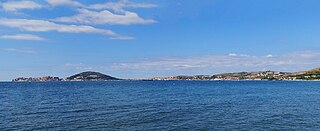Related Research Articles

Year 1036 (MXXXVI) was a leap year starting on Thursday of the Julian calendar.

Gaeta is a seaside resort in the province of Latina, in Lazio, Italy. Set on a promontory stretching towards the Gulf of Gaeta, it is 96.5 kilometres from Rome and 133 km (83 mi) from Naples.

The Duchy of Gaeta was an early medieval state centered on the coastal South Italian city of Gaeta. It began in the early ninth century as the local community began to grow autonomous as Byzantine power lagged in the Mediterranean and the peninsula due to Lombard and Saracen incursions.

The Duchy of Naples began as a Byzantine province that was constituted in the seventh century, in the reduced coastal lands that the Lombards had not conquered during their invasion of Italy in the sixth century. It was governed by a military commander (dux), and rapidly became a de facto independent state, lasting more than five centuries during the Early and High Middle Ages. Naples remains a significant metropolitan city in present-day Italy.
Richard Drengot was the count of Aversa (1049–1078), prince of Capua and duke of Gaeta (1064–1078).
John I was the second hypatos of Gaeta of his dynasty, a son of Dociblis I and Matrona, and perhaps the greatest of medieval Gaetan rulers.
The dukes of Naples were the military commanders of the ducatus Neapolitanus, a Byzantine outpost in Italy, one of the few remaining after the conquest of the Lombards. In 661, Emperor Constans II, highly interested in south Italian affairs, appointed a Neapolitan named Basil dux or magister militum. Thereafter a line of dukes, often largely independent and dynastic from the mid-ninth century, ruled until the coming of the Normans, a new menace they could not weather. The thirty-ninth and last duke, Sergius VII, surrendered his city to King Roger II of Sicily in 1137.
Medieval Amalfi was ruled, in the tenth and eleventh centuries, by a series of dukes, sometimes called dogi, corresponding with the republic of Venice, a maritime rival throughout the Middle Ages. Before the title of Duke of Amalfi was formally established in 957, various patricians governed the territory. Amalfi established itself as one of the earliest maritime trading powers renowned throughout the Mediterranean, considered for two centuries, one of the most powerful of the maritime republics.

The Archdiocese of Gaeta is a Latin Church ecclesiastical territory or archdiocese of the Catholic Church in southern Italy, in the city of Gaeta, in the Lazio region. The archbishop's cathedra is located in the Cathedral of SS. Erasmus and Marcianus and the Assumption of the Virgin Mary in the episcopal see of Gaeta. A non-metropolitan see, the archdiocese is immediately exempt to the Holy See.
Marinus II was the son of Docibilis II of Gaeta and Orania of Naples. He was made dux of Fondi by his father and his elder brother John II recognised this title. After his brother Gregory, who succeeded John, died, Marinus succeeded to the duchy of Gaeta and gave Fondi to his son Marinus. He was succeeded by his son John III and is the father of the Caetani family.
John V was the consul and duke of Gaeta from 1012 to 1032. He was the son of John IV and Sichelgaita, sister of Sergius IV of Naples. He was either very young when he succeeded his father or perhaps he was even born posthumously.
Emilia was the duchess of Gaeta first as consort of John III (984–1008) and then as the regent for her grandson John V (1012–1032) until at least 1029.
Leo I, sometimes called the Usurper, was the regent of the Duchy of Gaeta from 1017 until 1024. He was a younger son of Duke John III and Duchess Emilia. After the death of his brother, John IV in 1008, his mother took over the regency for her grandson, Leo's nephew, John V. Leo challenged his mother for the regency, successfully displacing her by 1017.
Leo II was the Duke of Gaeta briefly in early 1042. He was the last duke of the native Docibilan family. His father was the magnificus Docibilis, a grandson of Duke Gregory. His brother, Hugh, was the count of Suio.
John III was the consul and duke of Gaeta from some time between October 984 and January 986 until his death.
Dattus was a Lombard leader from Bari, the brother-in-law of Melus of Bari. He joined his brother-in-law in a 1009 revolt against Byzantine authority in southern Italy.
Jonathan, a member of a cadet branch of the Drengot family, was the Duke of Gaeta from 1113 until his death. He is known from the Codex Caietanus to have been in the fourth year of his minority in 1116 and the seventh of his rule in 1119. There are three theories of his paternity. He may have been the son of Count Jonathan I of Carinola or his grandson by an unnamed son, or else the grandson of Count Bartholomew of Carinola. He was under the regency of his cousin or uncle, Count Richard of Carinola.
Hugh was the Count of Suio in the Duchy of Gaeta. He was probably a son of Docibilis magnificus, who in turn was probably a son of Landolf, son of Gregory, Duke of Gaeta, and Landolf's mistress Polyssena (Pulessene). He was a brother of Duke Leo II of Gaeta.
Bernard was the Bishop of Gaeta for fifty years from his appointment in 997 until his death. He was a member of the Docibilan dynasty which ruled the Duchy of Gaeta from 867 to 1032. During his long episcopate he achieved the economic security of his see in the face of labour difficulties, annexed the diocese of Traetto to his own in or soon after 999, and witnessed the decline and replacement of his family in Gaeta.
References
- 1 2 Skinner 1995, Figure 1.1.